What the everyday life of volunteer combat medics looks like: stories of a hospital nurse
[ad_1]
In 2019, rallies were held in Tbilisi under the Russian embassy. During the clashes, law enforcement officers doused the crowd with tear gas and beat the protesters. Among them was 25-year-old Ukrainian Tanya Romaniuk.
She was helped by people in white vests with a red cross. Then the girl realized for the first time how important it is to provide first aid correctly and on time.
Tania is now 30, and for almost two years she has been a volunteer in the “Hospitaliers” medical battalion, where she directly provides first aid and rescues soldiers from the front line.
“UP.Zhyttia” spoke with Tanya Romanyuk about the rally that changed her life, the liberation of Kherson, and stories about the rescue of soldiers.
How first aid became a part of life
The Revolution of Dignity irreversibly changed Tanya’s student life. The girl took an active part in protests, defended her European future. Then, fortunately, she did not have to seek medical help. However, the actions of the paramedics fascinated the girl, so the idea of helping people “settled” in her head.
Tanya will return to this opinion 5 years later, during a trip to Georgia, where at a rally she will receive “friendly” blows with sticks from law enforcement officers.
After her return, the girl will take several courses in first aid and become a member of the rapid response team. Before the full-scale invasion, their group will go to rallies, protests, mass events.
Tanya is in the rapid response group in the Kyiv region
photo from the archive
This will not happen very often – the girl will have enough time to do her favorite thing – ceramics.
Tanya also volunteered at the Ukrainian Leadership Academy (UAL). She worked with teenagers and children who found themselves in difficult life circumstances. Later, she became a volunteer mentor, that is, she taught young people to do good for free.
. The girl says that she saw great meaning in this, because she helped raise a new conscious generation in Ukrainian society.
“The program at UAL teaches young people to be active, not to complain that, oh my God, in which country we live or if a new president comes – everything will be done. Instead, students took responsibility and started to implement changes. For example, they looked for how to repair a bench in the yard or who has patch the hole“, she explains.

Tanya with UAL students
photo from the archive
“Hospitaliers” volunteer
When the full-scale invasion began, the girl, together with the rapid response units, went to the victims in the destroyed houses. She also helped evacuate people with limited mobility from the Kyiv region through green corridors.
When the Russians withdrew from Kyiv Oblast, Tanya took a 2-month leave from UAL and went to the front-line territories to evacuate civilians.
“At that moment, I understood that it is extremely important to take out the civilian population – old grandmothers and grandfathers, people with disabilities, etc. But more importantly – save the military, because otherwise export civilians will be for no one and never”says the girl.
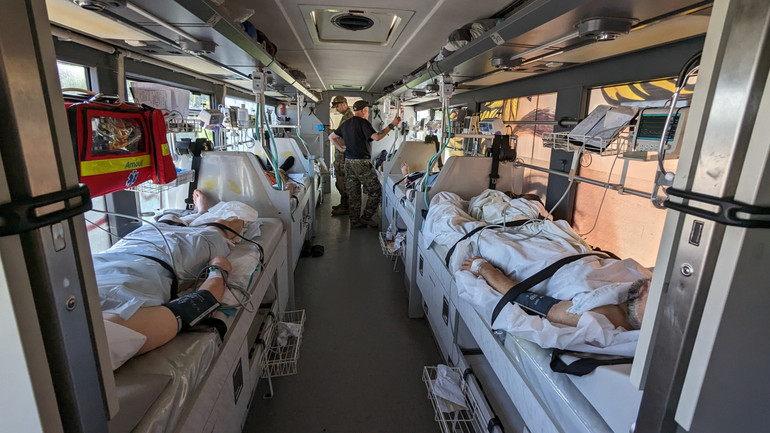
Evacuation of people with reduced mobility from Donetsk region
photo from the archive
So she decided to join the Hospitallers. I wrote to my friend, who was already a volunteer of this battalion, and found out that there is already a whole queue of those willing. But Tanya was already a paramedic, so she managed to join faster than others.
“My first rotation was during the de-occupation of the Kherson region, when everyone took a picture with a watermelon. We found the moment of liberation, and this feeling was stronger than the euphoria I had known.
After hospital training, you immediately get to the headquarters, where it’s just a dumpling made of wounded“, the volunteer recalls.
For the first four days in the Kherson region, fighters with various injuries – from light to very severe – were transported non-stop. In this endless stream of wounded, Tanya was finally convinced that she wanted to do medical care for the military.
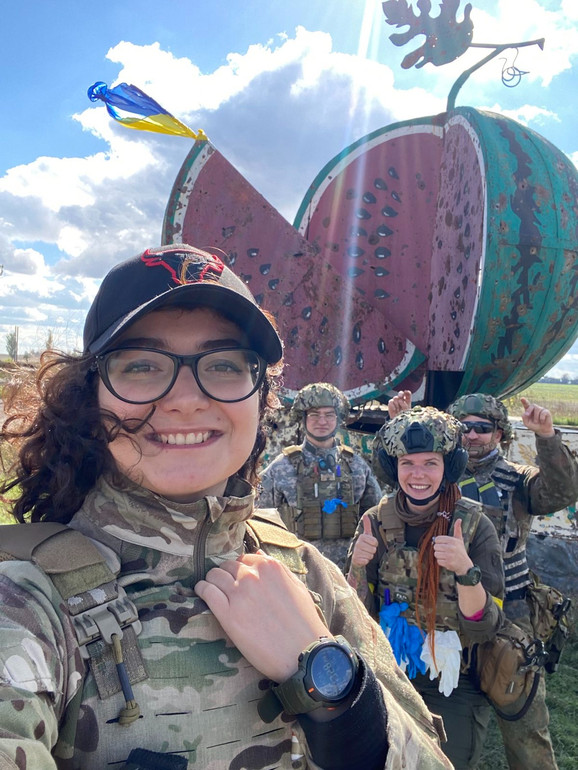
The first rotation of “Hospitaliers” in the Kherson region
photo from the archive
“It is very important to protect the lives of our boys and girls who are currently serving. These are the people who liberate Ukraine and protect it. I hope that they all return home alive“, Tanya adds.
Tanya’s “baptism in combat” took place in the Kherson region. Then she worked on a medevac (a car for evacuation, where there is not only a paramedic, but also a doctor).
The girl remembers that in one shift the crew brought the most 28 wounded, but their colleagues also delivered 90 soldiers with various injuries per shift. There were many wounded in the Kherson region. Doctors slept no more than 4-5 hours. They were on duty in shifts, resting only between “inflows” of injured soldiers. Sometimes the break lasted 55 minutes, sometimes only 5.
How the “Hospitaliers” battalion is organized
The work of a tactical medic based on TCCC first aid protocols based on the MARCH algorithm. After training, the paramedic of the battalion can always turn to instructors and more experienced colleagues if any questions arise in the work.
“The protocol is very simple and should always be followed when providing aid. Practice the skill of automatism so that even when the head is disabled due to shelling, you continue to save the life of the wounded“, Tanya notes.
In addition to paramedics, there are also doctors in the team. Usually these are narrow specialists, such as surgeons, anesthesiologists, resuscitators, otolaryngologists, etc. They join the team during their vacations. For example, they go to the front for 2 weeks or a month instead of rest.
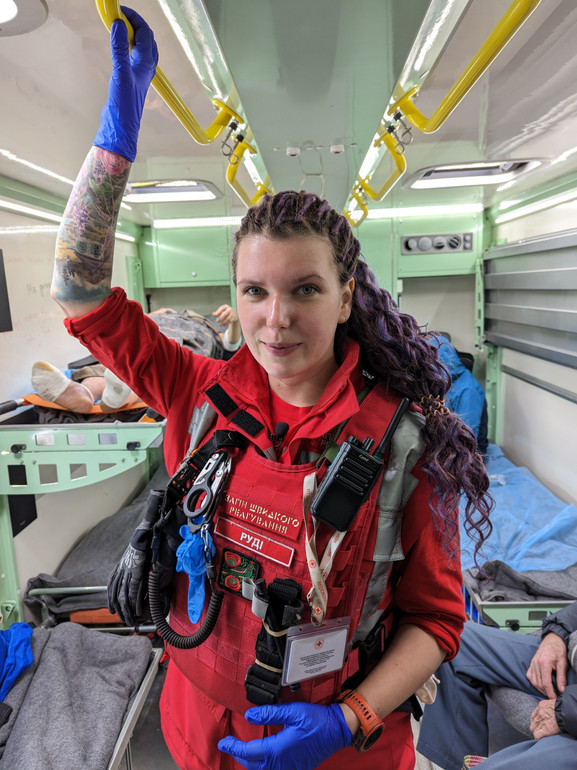
Tanya is in the rapid response unit
photo from the archive
“What I like about the Hospitallers is that all volunteers will not be paid, but instead have common values - they want to save the lives of the military“, says the volunteer.
Tanya adds that the battalion has several formats. For example, there is a kesevak – these are crews on off-road vehicles that drive as close as possible to the front. Paramedics work on the principle of “grab and run”, their goal is to bring the wounded to the next stage as quickly as possible.
A medevac is already a medical crew, a kind of ambulance with medical equipment, on which you can overload the wounded. Doctors there can provide more help. For example, put a monitor to measure the patient’s vital signs, use a defibrillator or a device for artificial ventilation. There is even a resuscitation bus named after the fallen paramedic with the call sign “Austrian”.
Tanya says that she really likes long evacuation flights that last 6-8 hours. This is usually the transportation of the wounded to military hospitals in the front-line regions – in Zaporizhzhia or Dnipro. During this time, the paramedic has time to learn not only the name, surname and remember the injuries of the wounded, but also to get to know and communicate with the soldier.
“I remember one guy really wanted to call his wife. I gave him my phone and I captured his tears of joy when he started talking to the woman and you could hear her crying too because he was alive. It’s so precious – to be able to share moments of both pain and joy with the wounded”– recalls the hospitalist.
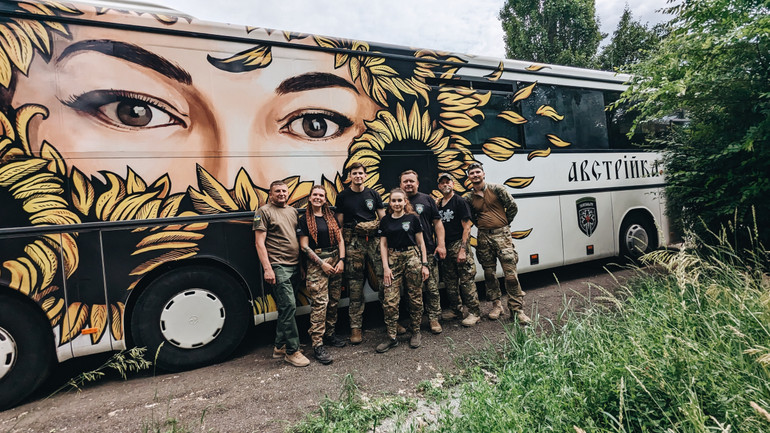
“Austria” evacuation bus
photo from the archive
Stabilization point (stabpunkt) is a place where combat medics evacuate the wounded from the front line. Here they provide first aid, stabilize their condition and send them to the hospital.
“The most difficult thing for me is when you hear on the radio the call of the crew to the wounded, but the group cannot leave because there is constant shelling. It happened that they could not take the wounded for a day – then these 300 become 200 (that is, they die) , because it is impossible to reach them.
But it’s even worse when you take the wounded, but it’s too late. You do everything you can, but unfortunately it doesn’t work. I had such an injury. If they had brought him half an hour sooner, he would have been alive, but he leaked… We poured fluids and took him to the hospital, but then his heart stopped.”– Tanya says with bitterness in her voice.
Sad and funny field stories
During the rotation near Kupyansk, 14 soldiers were brought to the headquarters where Tanya worked. They had different injuries and their condition also differed. The medics started sorting, one of the boys was very pale, but with a slight injury. He was asked to wait while they rescued his heavier brothers.
“The fighter leaned against a tree and at some point began to slide along it, as if losing consciousness. He was quickly seated at a table and asked to wait a little longer. There were canned goods, stew, and mivina on the table.
I was treating another guy’s wound when I come back to it – and he is enthusiastically spooning the stew. Before that, he was completely exhausted, he could barely speak, but now he is waving the spoon so enthusiastically! ” – Tanya says with a smile.
She adds that a little later the boy said that he had spent several days in the positions without food. So his well-being was greatly improved by a small portion of canned food.
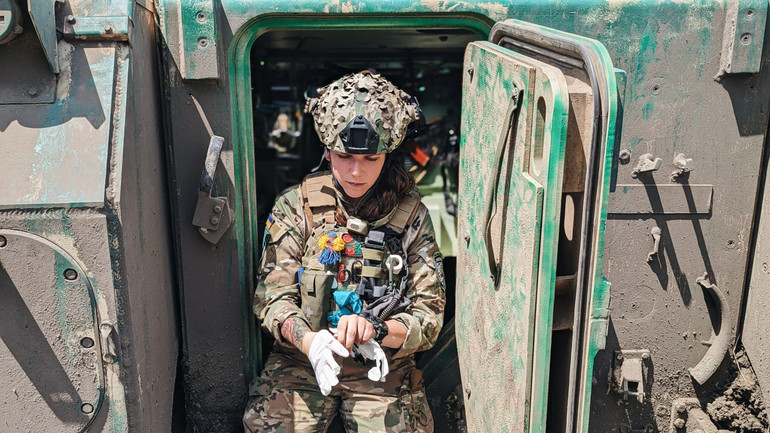
Tanya on an armored vehicle for evacuating the wounded
photo from the archive
Tanya remembered another fighter by singing and tears. A military man was brought to the headquarters, who had a tourniquet applied to him for more than 8 hours. He was wrapped in a thermal blanket, the wound was treated.
The hospitalist was standing and talking to this man. He looked to be about 45 years old, and he asked several times why he was being taken for so long.
“At some point he stopped hearing me and instead sang a song about a goat that lost its leg. And cried.
It was his realization that he would lose a limb due to the long evacuation. He had eyes like a child’s – light blue and large, but his gaze was empty. Oto looks through me, sings this song about a goat and cries“, the paramedic recalls.
A look at civilian life
After a year and a half in the rotations, Tanya does not feel much burnout. Instead, she feels more useful on the front than in civilian life.
She says that she feels more burnt out and powerless when she returns to Kyiv because of the indifference of the residents and the Russian language on the streets.
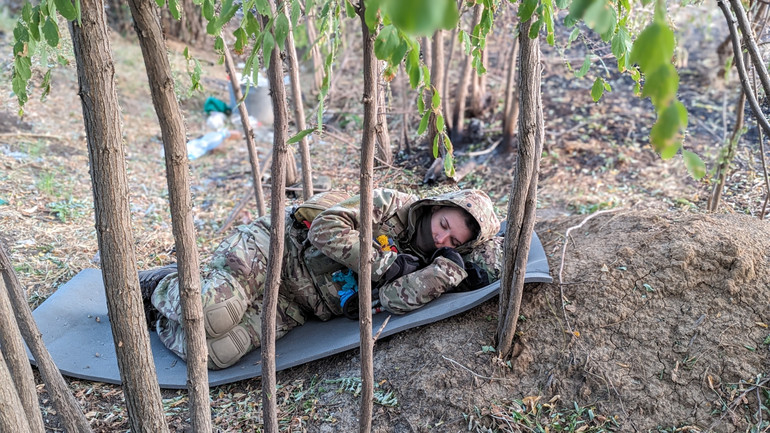
Rest for the combat medic
photo from the archive
“UAL offers me to return to teaching in a new position – safety mentor. I understand how important it is to raise the new generation to be responsible. We need an active society in order to preserve the memory of the dead, of all these events, so that this does not happen again in the future.
But I know that I will not be comfortable living in the city, working and being less useful, because I know that boys are dying there right now, at this moment. There are battles going on somewhere, there are wounded and they need helpa”, Tanya emphasizes.
Victoria Andreeva, UP. Life
[ad_2]
Original Source Link











